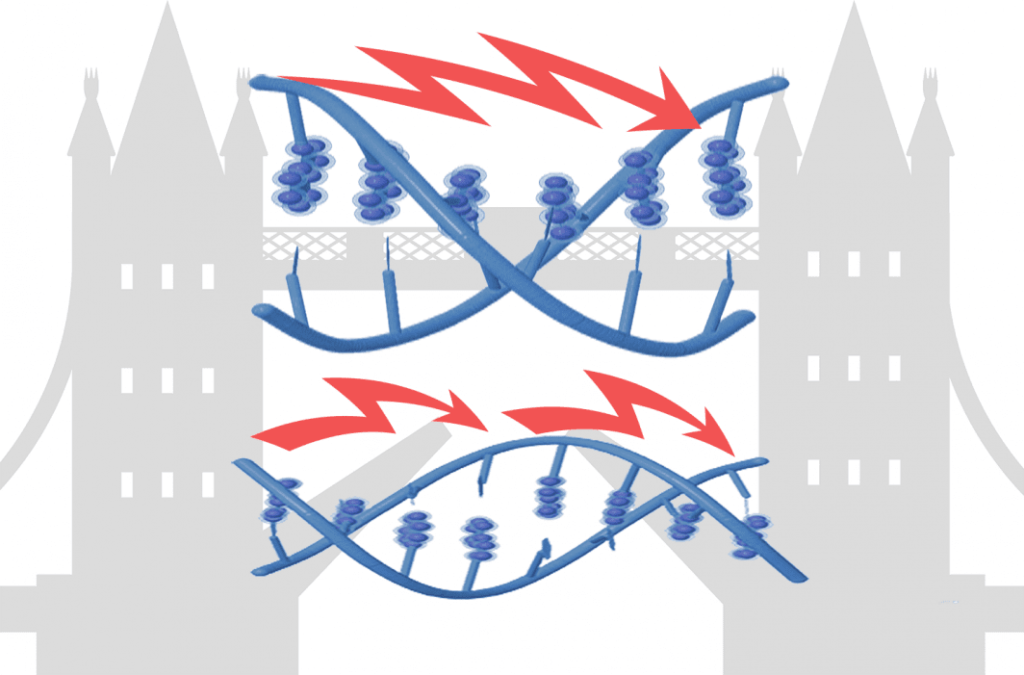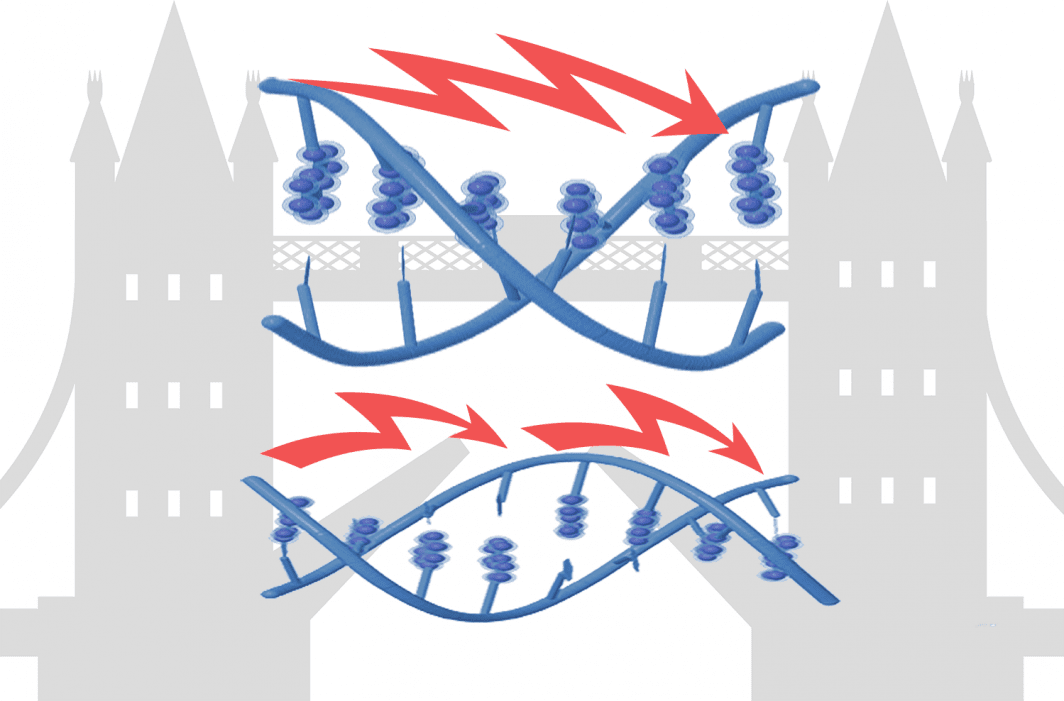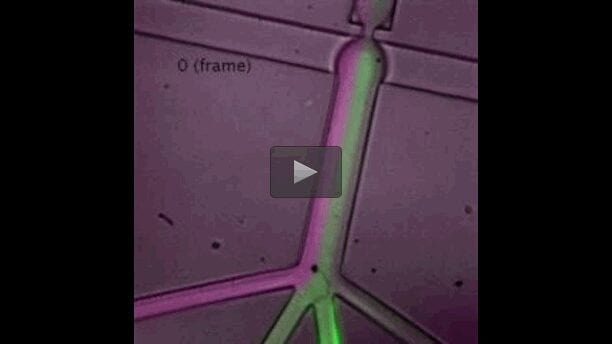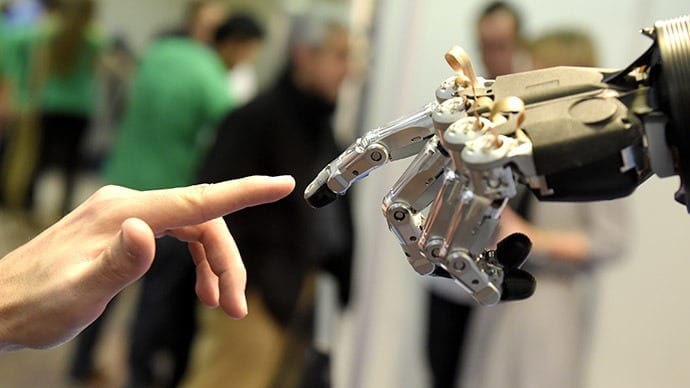
DNA may be the blueprint of life, but it’s also a molecule made from just a few simple chemical building blocks. Among its properties is the ability to conduct an electrical charge, fueling an engineering race to develop novel, low-cost nanoelectronic devices.
Now, a team led by ASU Biodesign Institute researcher Nongjian “N.J.” Tao and Duke theorist David Beratan has been able to understand and manipulate DNA to more finely tune the flow of electricity through it. The key findings, which can make DNA behave in different ways — cajoling electrons to smoothly flow like electricity through a metal wire, or hopping electrons about like the semiconductors materials that power our computers and cellphones — pave the way for an exciting new avenue of research advancements.
The results, published in the online edition of Nature Chemistry, may provide a framework for engineering more stable and efficient DNA nanowires, and for understanding how DNA conductivity might be used to identify gene damage.
Building on a series of recent works, the team has been able to better understand the physical forces behind DNA’s affinity for electrons.
“We’ve been able to show theoretically and experimentally that we can make DNA tunable by changing the sequence of the ‘A, T, C, or G’ chemical bases, by varying its length, by stacking them in different ways and directions, or by bathing it in different watery environments,” said Tao, who directs the Biodesign Center for Biolectronics and Biosensors and is a professor in the Ira A. Fulton Schools of Engineering.
Along with Tao, the research team consisted of ASU colleagues, including lead co-author Limin Xiang and Yueqi Li, and Duke University’s Chaoren Liu, Peng Zheng and David Beratan.
Untapped potential
Every molecule or substance has its own unique attraction for electrons — the negatively charged particles that dance around every atom. Some molecules are selfish and hold onto or gain electrons at all costs, while others are far more generous, donating them more freely to others in need.
But in the chemistry of life, it takes two to tango. For every electron donor there is an acceptor. These different electron dance partners drive so-called redox reactions, providing energy for the majority of the basic chemical processes in our bodies.
For example, when we eat food, a single sugar molecule gets broken down to generate 24 electrons that go on to fuel our bodies. Every DNA molecule contains energy, known as a redox potential, measured in tenths of electron volts. This electrical potential is similarly generated in the outer membrane of every nerve cell, where neurotransmitters trigger electronic communication between the 100 trillion neurons that form our thoughts.
But here’s where the ability of DNA to conduct an electrical charge gets complicated. And it’s all because of the special properties of electrons — where they can behave like waves or particles due to the inherent weirdness of quantum mechanics.
Scientists have long disagreed over exactly how electrons travel along strands of DNA, said David N. Beratan, professor of chemistry at Duke University and leader of the Duke team.
“Think of trying to get across a river,” explained Limin Xiang, a postdoctoral researcher in Tao’s lab. “You can either walk across quickly on a bridge or try to hop from one rock to another. The electrons in DNA behave in similar ways as trying to get across the river, depending on the chemical information contained within the DNA.”
Previous findings by Tao (pictured left) showed that over short distances, the electrons flow across DNA by quantum tunneling that spread fast like waves across a pond. Across longer distances, they behave more like particles and the hopping takes effect.
This result was intriguing, said Duke graduate student and co-lead author Chaoren Liu, because electrons that travel in waves are essentially entering the “fast lane,” moving with more organization and efficiency than those that hop.
“In our studies, we first wanted to confirm that this wave-like behavior actually existed over longer distances,” Liu said. “And second, we wanted to understand the mechanism so that we could make this wave-like behavior stronger or extend it to longer distances.“
Flick of the switch
DNA strands are built like chains, with each link comprising one of four molecular bases whose sequence codes the genetic instructions for our cells. Like metal chains, DNA strands can easily change shape, bending, curling and wiggling around as they collide with other molecules around them.
All of this bending and wiggling can disrupt the ability of the electrons to travel like waves. Previously, it was believed that the electrons could only be shared over at most three bases.
Using computer simulations, the Beratan team found that certain sequences of bases could enhance the electron sharing, leading to wave-like behavior over long distances. In particular, they found that stacking alternating series of five guanine (G) bases created the best electrical conductivity.
The team theorizes that creating these blocks of G bases causes them to all “lock” together so the wave-like behavior of the electrons is less likely to be disrupted by the random motions of the DNA strand.
“We can think of the bases being effectively linked together so they all move as one. This helps the electron be shared within the blocks,” Liu said.
Next, the Tao group carried out conductivity experiments on short, six to 16 base strands of DNA, carrying alternating blocks of three to eight guanine bases. By tethering their test DNA between a pair of two gold electrodes, the team could flip on and control a small current to measure the amount of electrical charge flowing through the molecule.
They found that by varying a simple repeating “CxGx” pattern of DNA letters (x is the odd- or even-numbered G or C letters), there was an odd-even pattern in the ability of DNA to transport electrons. With an odd number, there was less resistance, and the electrons flowed faster and more freely (more wave-like) to blaze a path across the DNA.
They were able to exert precise molecular-level control and make the electrons hop (known as incoherent transport, the type found in most semiconductors) or flow faster (coherent transport, the type found in metals) based on variations in the DNA sequence pattern.
The experimental work confirmed the predictions of the theory.
Information charge
The results shed light on a long-standing controversy over the exact nature of electron transport in DNA and might provide insight into the design of DNA nanoelectrics and the role of electron transport in biological systems, Beratan said.
In addition to practical DNA-based electronic applications (for which the group has filed several patents), one of the more intriguing aspects is relating their work — done with short simple stretches of DNA — back to the complex biology of DNA thriving inside of every cell.
Of upmost importance to survival is maintaining the fidelity of DNA to pass along an exact copy of the DNA sequence every time a cell divides. Despite many redundant protection mechanisms in the cell, sometimes things go awry, causing disease. For example, absorbing too much UV light can mutate DNA and trigger skin cancer.
One of the DNA chemical letters, “G,” is the most susceptible to oxidative damage by losing an electron (think of rusting iron — a result of a similar oxidation process). Xiang points out that long stretches of Gs are also found on the ends of every chromosome, maintained by a special enzyme known as telomerase. Shortening of these G stretches has been associated with aging.
But for now, the research team has solved the riddle of how the DNA information influences the electrical charge.
“This theoretical framework shows us that the exact sequence of the DNA helps dictate whether electrons might travel like particles, and when they might travel like waves,” Beratan said. “You could say we are engineering the wave-like personality of the electron.”
Learn more: Scientists engineer tunable DNA for electronics applications
The Latest on: Tunable DNA
[google_news title=”” keyword=”tunable DNA” num_posts=”10″ blurb_length=”0″ show_thumb=”left”]
via Google News
The Latest on: Tunable DNA
- Ancient DNA Newson May 4, 2024 at 5:00 pm
DNA Study IDs Descendants of George Washington from Unmarked Remains, Findings to Aid Service Member IDs Going Back to World War II Mar. 28, 2024 — New DNA sequencing technologies have ...
- Best DNA Test for 2024on May 3, 2024 at 4:01 am
CNET’s expert staff reviews and rates dozens of new products and services each month, building on more than a quarter century of expertise. Open up even more of your world with the best at-home ...
- Biotechnology and Bioengineering Newson April 29, 2024 at 5:00 pm
Mar. 6, 2024 — 'Random DNA' is naturally active in the one-celled ... Using Computers to Design Proteins Allows Researchers to Make Tunable Hydrogels That Can Form Both Inside and Outside ...
- Ancient DNA pulls back curtain on mysterious empireon April 27, 2024 at 8:00 am
Editor’s note: A version of this story appeared in CNN’s Wonder Theory science newsletter. To get it in your inbox, sign up for free here. Primarily known from the accounts of their Byzantine ...
- Neuroscientists Discover Shapeshifting DNA Controls Memory Formationon April 17, 2024 at 9:16 am
Neuroscientists have uncovered a new mechanism for memory formation, and it involves changes in the structure of your DNA. If you were asked to picture a molecule of DNA, chances are you would ...
- Biologists reveal how gyrase resolves DNA entanglementson April 10, 2024 at 5:00 pm
The coiled telephone cord and the DNA double helix that stores the genetic material in every cell in the body have one thing in common; they both supercoil, or coil about themselves, and tangle in ...
- DNA lab knew its paternity tests identified the wrong dads — but kept selling them: reporton April 9, 2024 at 9:41 am
Officials at a Canadian DNA lab knew its prenatal paternity tests were misidentifying babies’ biological fathers, often ruling out the true dads — but continued to sell the tests for more than ...
- Drug Kinetics – News and Featureson April 5, 2024 at 11:22 pm
The laboratory of Professor Hendrik Dietz in the Department of Physics explores the possibility of building molecular devices at the nanometer scale using different materials, including DNA. The group ...
- Dog DNA tests are on the rise—but are they reliable?on April 2, 2024 at 4:59 pm
Is your new shelter pup part beagle or boxer? Many pet owners seek answers to these questions, and as a result, direct-to-consumer dog DNA testing is booming. But how reliable are dog DNA tests ...
- Dog DNA Company Insists Human DNA Is Actually Alaskan Malamuteon March 16, 2024 at 8:30 am
An at-home DNA testing kit for dogs claimed that human saliva returned various dog breed results — and when pressed, the firm held firm. The dog DNA debacle began last fall, when the local ...
via Bing News











